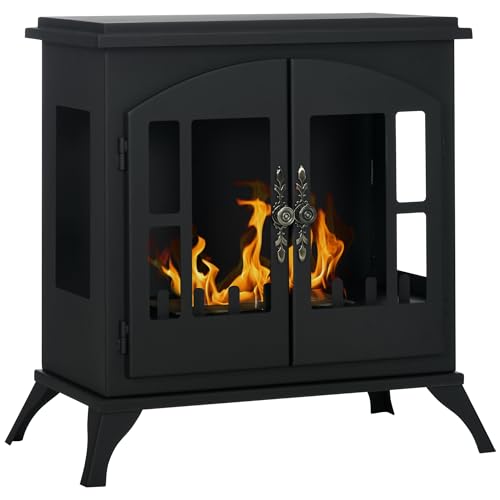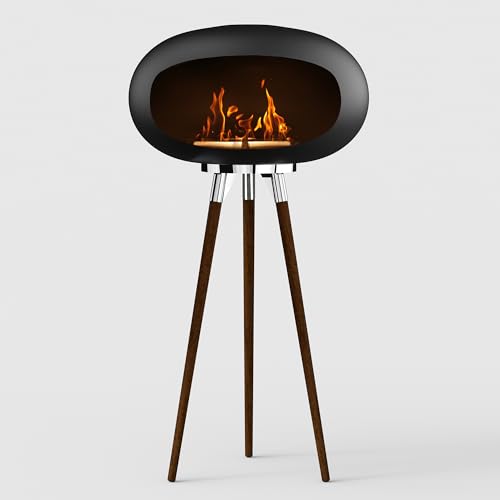You'll Never Be Able To Figure Out This Bio Ethanol Fire Free Standing…
페이지 정보

본문
 Bio Ethanol Fire Free Standing
Bio Ethanol Fire Free StandingA bio-ethanol freestanding ethanol fireplace fire is a contemporary fireplace that burns liquid ethanol fuel. It doesn't emit smoke or fumes and is extremely easy to use.
Simply add the bioethanol to the burner and then light. To put out the flame, simply slide the closing rod over top of it to starve the oxygen.
Burn time
You may have been discouraged from installing a fireplace due to of the expense. Thanks to modern technology, a bioethanol fireplace is now an alternative. This type of fireplace runs on liquid ethanol fuel that produces no smoke or fumes. It is also safe for indoor use, and does not require a chimney or a flue. As with any flammable fuel it is essential to keep track of the amount of fuel being utilized and be aware when moving the unit.
Bioethanol fireplaces are available in different designs and are simple to set up. All you have to do is fill the fireplace with bioethanol fuel and then light it. Then, you can enjoy your new fireplace. Many models are portable, which means they can be easily moved from one room to another. You can even place them outside if you like. Make sure your home is adequately ventilated to prevent the buildup of pollutants and carbon dioxide.
These fireplaces are great for people who want an old-fashioned look but don't want to spend money on a chimney installation. They don't emit fumes or smoke and are easy to install. They're also an excellent option to reduce heating costs. Some even have a fake flue to give an authentic appearance.
There are two kinds of bioethanol fireplaces, inserts and wall mounted. Inserts are essentially burners with glass shields to protect the open flame. It can be installed in any existing fireplace for modern appearance. Inserts can be found in a wide range of shapes and sizes, so you can find one that will fit the space perfectly.
A wall-mounted bioethanol fire is a great choice for those who want to add a touch of modernity to their home. It's a great substitute for a wood-burning or electric fire place, and can be placed anywhere in the house. They are also less complicated and more easy to maintain than traditional fire places and can be moved from one area to another.
Safety
As long the fire is put on a solid surface and is kept at a safe distance away from curtains and other flammable materials and other flammable materials, a free-standing bio-ethanol fireplace is safe to use. They do not emit carbon monoxide, and the flames they produce are less intense than those produced by gas or wood stoves. They also don't emit soot or smoke and require very little maintenance. Like any fire or fireplace, it is important to keep them in a well ventilated space and never leave them unattended.
To prevent damage and accidents To avoid damage and accidents, ethanol fireplaces must be installed and maintained properly. They should be constructed of a durable material and evaluated by an independent testing company to ensure that they are in compliance with industry standards. In addition, the user instructions must clearly explain any potential dangers and give specific guidelines for using them.
The fuel ethanol used in these fires comes from the fermentation of grain, sugarcane and other plant by-products using yeast. Although these fuels are more sustainable than fossil fuels, they can be a source of pollution because they produce trace amounts of carbon dioxide as well as other gases that can irritate the lungs if breathed in regularly. Additionally, crops grown for ethanol are stealing the land that could be used to grow food.
The ethanol fireplace is safer than other fireplaces because it doesn't have large fuel tanks and connections that can leak or malfunction. However, they are not completely safe because the fuel is liquid and could spill out of the tank in the event that the fire is knocked over or if you fail to switch off the fire when you leave the room.
If this happens, the flame could spread to other areas of the room. Be sure to keep an extinguisher nearby to the burner or by avoiding touching it with bare hands. When using a bio-ethanol fireplace it is recommended you open the windows a little to allow fresh air into the space.
Ventilation
If you have a bioethanol fireplace, proper ventilation is important. Ventilation is important to remove combustion byproducts and also allowing fresh air to enter into the room. This helps maintain an ambiance that is comfortable. A properly vented fire can also help prevent the poisoning of carbon monoxide and other health problems. Additionally, it helps reduce humidity and increases the effectiveness of your heating system. Therefore, you should adhere to the manufacturer's recommendations on proper ventilation and make sure that your home is properly ventilated when you use a Bio ethanol fireplace.
The majority of freestanding bio-ethanol fireplaces appear like wood fireplaces however, unlike wood stoves, they don't require wood to burn. Instead, these fireplaces use a liquid fuel called bioethanol which is made from the waste of certain crops like sugar cane and maize. The fuel is then distilled, purified and then used in fireplaces.
These fireplaces made of bioethanol are very adaptable, as they do not require a chimney system or venting, and can be moved to any area of the room. This flexibility is particularly beneficial for apartments or homes with small spaces that have limited space. Bio ethanol fireplaces are also suitable for outdoor use, provided they are shielded from wind and rain.
The design of these fireplaces is extremely variable with a range of styles from a simple, cylindrical design to more rustic and traditional style. They can be erected on the wall or on a table and are available in various colors and materials. Some models can be built into the wall, creating a stylish accent piece for your living space.
Fireplaces can be found in home improvement stores, specialty fireplace stores, and even online retailers. They are simple to maintain and can be utilized in any setting. Ethanol fires are clean and emit no harmful gases, making them an environmentally-friendly alternative to wood or gas fireplaces. They may emit a mild scent when they first start to burn. This should quickly dissipate.
They are safe, but they must be kept away from curtains and flammable items. Additionally, they should never be moved when they are lit, as it can cause burns or other damage to the surroundings. Avoid them in areas with drafts because they could generate smoke.
Installation
Ethanol Fireplaces are a great addition to any home. They can be set up easily. They can be positioned anywhere in the room and don't require gas pipes or chimneys. They are powered by a liquid fuel derived from renewable sources called bioethanol. They produce less soot and ash than fossil fuels such as coal or oil. Ethanol-burning fires also don't emit volatile organic compounds into the air, which can cause respiratory problems and irritation to lungs.
There are various styles available for bio-ethanol fireplaces, including freestanding and wall-mounted models. The installation process can vary depending on the kind of fireplace you select. Most fireplaces come with instructions on how to install the fireplace in a proper manner. The most important thing to do is follow the guidelines provided by the manufacturer. These guidelines will ensure that your bio-fireplace's safety and won't harm any surfaces.
Most recessed ethanol fires come with built-in tanks that hold the fuel in liquid form. These tanks must be insulated, and then placed on walls that are not combustible. The ethanol burner must be located at least one millimeter away from any combustible materials, such as furniture or curtains. The tank should also be kept in a cool, dry place and out of reach from children and pets.
Another benefit of a fireplace made of ethanol is that it is portable, which means that you can move it from one place to the next without a complicated installation. This makes it perfect for apartments and single-family homes as well as hotels and restaurants. It is also easy to set up, since there is no requirement for a chimney or electrical connection.
best freestanding bioethanol fireplace ethanol fireplaces are excellent option for homeowners looking to add a modern touch to their homes. They don't produce harmful fumes or gases, so they make an ideal alternative to traditional wood-burning fireplaces. They are also simple to clean and use. The only disadvantage to using a free standing bio ethanol stove-floor standing bio ethanol fireplace ethanol fire is that it may be difficult to locate bioethanol fuel in your area. It is possible to purchase it from an online retailer or a specialist retailer.

- 이전글The 10 Scariest Things About Eastleigh Frames 24.12.17
- 다음글9 Things Your Parents Taught You About Free Standing Modern Electric Fireplace 24.12.17
댓글목록
등록된 댓글이 없습니다.


